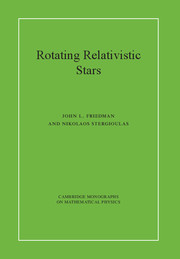Book contents
- Frontmatter
- Dedication
- Contents
- Preface
- List of symbols
- Conventions, notation, and mathematical preliminaries
- 1 Stationary, axisymmetric equilibria
- 2 3+1 split, action, Lagrangian, and Hamiltonian formalisms
- 3 Asymptotics, virial identities, and nonaxisymmetric equilibria
- 4 Numerical schemes
- 5 Equilibrium models
- 6 Approximation methods for equilibria
- 7 Perturbation theory of relativistic fluids
- 8 Quasinormal modes
- 9 Stellar stability
- 10 Nonlinear dynamics of rotating relativistic stars
- Appendix A Lie derivatives, forms, densities, and integration
- Appendix B The Newtonian limit of the two-potential formalism
- Bibliography
- Index
5 - Equilibrium models
Published online by Cambridge University Press: 05 July 2013
- Frontmatter
- Dedication
- Contents
- Preface
- List of symbols
- Conventions, notation, and mathematical preliminaries
- 1 Stationary, axisymmetric equilibria
- 2 3+1 split, action, Lagrangian, and Hamiltonian formalisms
- 3 Asymptotics, virial identities, and nonaxisymmetric equilibria
- 4 Numerical schemes
- 5 Equilibrium models
- 6 Approximation methods for equilibria
- 7 Perturbation theory of relativistic fluids
- 8 Quasinormal modes
- 9 Stellar stability
- 10 Nonlinear dynamics of rotating relativistic stars
- Appendix A Lie derivatives, forms, densities, and integration
- Appendix B The Newtonian limit of the two-potential formalism
- Bibliography
- Index
Summary
Models in uniform rotation
Bulk properties
Neutron star models constructed with different proposed EOSs have strikingly different bulk properties, due to the large uncertainties in the equation of state above nuclear density. The overall relation between the equation of state and the structure of the star is easy to see: Because more compressible (soft) EOSs require a higher density to supply the same pressure, they yield stellar models with higher central density and smaller radius for a given mass than models based on less compressible (stiff) EOSs. Because less compact models have less gravitational binding energy for the same mass, models based on stiff EOSs can support more mass against gravitational collapse. Thus the maximum mass for a given EOS increases as the EOS becomes less compressible, attaining its largest value for models based on an incompressible EOS - for uniform-density models. Because the moment of inertia increases with increasing mass and (quadratically) with increasing radius, it shows the most rapid rate of increase with increasing stiffness of the EOS. On the other hand, because more compact stars can spin faster before reaching their maximum (Keplerian) rotation, the maximum spin for a fixed baryon mass increases as the compressibility increases.
- Type
- Chapter
- Information
- Rotating Relativistic Stars , pp. 109 - 134Publisher: Cambridge University PressPrint publication year: 2013



